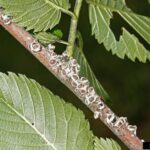European Elm Scale
Scale Insects
European Elm Scale (Gossyparia spuria) is a type of scale insect that infests the leaves and branches of elm trees. Scale insects are small, immobile insects that feed on the sap of trees and other plants. They have a protective covering, called a "scale", that protects them from predators and environmental stress. European Elm Scale is a species of soft scale insect and has a white, cotton-like appearance.
The insects feed on the sap of the elm tree and can cause damage to the tree's branches and leaves. When the tree is heavily infested, it can experience stunted growth, yellowing leaves, and even death. The insects also produce a large amount of honeydew, a sugary excretion, which can attract ants and other insects and provide a substrate for the growth of sooty mold. This can further harm the tree by reducing its ability to photosynthesize and produce food.
Control of European Elm Scale is difficult and often requires a multi-pronged approach. Regular monitoring and early detection of infestations can help prevent significant damage to the tree. Pruning and removing heavily infested branches and leaves can help reduce the population of insects. Systemic insecticides can also be applied to the tree, either as a soil drench or as a trunk injection, to kill the insects. However, these treatments must be applied by a licensed professional and the timing must be correct in order to be effective.
In addition to control measures, it is also important to prevent the spread of the insect. Infested trees should not be moved from one location to another and nearby trees should be monitored for signs of infestation. Planting elm trees that are resistant to scale insects, such as American Elm, is also a helpful preventative measure.
Overall, European Elm Scale can cause significant harm to elm trees and control measures must be taken to prevent damage and reduce the spread of the insect.



